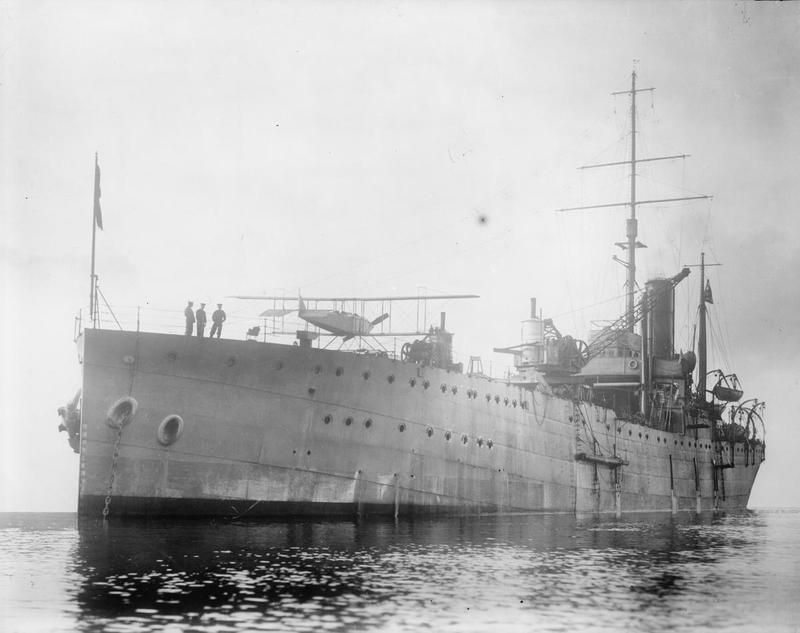Above and Below the Waves
At Scapa Flow, Admiral Beatty was in now established in command of the Grand Fleet, aboard his flagship HMS Royal Sovereign.
Since the Battle of Stavanger, the fleet had been reinforced by the battleships Royal George and Canada, who joined their sisters and the ‘Queen Elizabeths’ to complete 5th Battle Squadron. However, with a realistic top speed of 23½ knots, the C-in-C knew that this squadron’s place was as a fast vanguard for the Grand Fleet, not as heavy support for the battlecruisers.
Although he had lobbied hard for them to join the Battle Cruiser Fleet early in 1916, the experience of battle and the responsibility of command had affected his views. The two groups of fast ships had become separated at Stavanger, and Beatty didn’t want the BCF’s new commander to risk taking on the German Fleet on his own.
In any case, Admiral Sturdee already had a powerful force; since the battle in August 1916, the BCF had been strengthened by the addition of Renown, Courageous and Glorious, while in January, Repulse had returned to service after five months of repairs.
In addition to repairs to battle damage, Repulse had received significant improvements to her protection, along lines that would form a prototype for other ships. The greatest change was the addition of ‘bulges’ along the sides of the hull, intended to protect against torpedo attack. The idea had been tried before in cruisers, and an internal bulge was included in some of the most modern designs, but this was the first time that one had been retrofitted to a large ship.
The bulges added 10' to the ship's beam underwater and met the existing hull at the bottom of the belt. In addition, there was a 2" increase to the lower deck and slopes over the magazines (giving 3” and 4” respectively), along with several improvements to range-finding equipment, which raised her displacement to 30,670 tons normal, or 34,850 tons full load.
The ship was wanted back in service immediately and there was no time for formal trials, but after a brief refit in 1918, she achieved 29.86 knots with 122,260 shp while displacing 32,650 tons. At that time, her engines did not achieve as high a rev rate as they should have, showing that there was a mismatch between the propellers and the speed/power curve of the modified hull. Her Chief Engineer and later her Captain requested that new props be fitted, but with other ships in greater need of refits, the war would be long over before that was done.
Aside from improvements to current vessels and revisions to battle orders and tactics, consideration was being given to the future, as the Naval Aircraft Committee reported in February 1917.
The use of aircraft at Stavanger had produced two important results; it had given Admiral Jellicoe additional information about the location of both the enemy and the BCF, and the following day, a German attempt at reconnaissance had been interrupted when a seaplane shot down a Zeppelin.
Floatplanes were now being carried aboard several battleships and cruisers, while at the other end of the scale there was an idea for a set of ‘aviation vessels’ to be used to launch strikes against enemy ships in harbour. However, this was regarded as rather fanciful; the ships did not exist, and the practice of dropping torpedoes from aeroplanes had barely been tested.
There was considerable debate as to the possible value of attempting to bomb ships, as numerous officers pointed out that even a 500-pound bomb was small in comparison to the half-ton or one-ton shells that capital ships were designed to resist. A few argued that a bomb falling on a deck might do some damage, but probably no more than an equivalent weight of shell. The report called for trials to be made, but in the heat of war the resources for this were needed elsewhere.
However, the report also concluded that disrupting aerial reconnaissance would be increasingly important, and following successful trials in 1916, it was suggested that fighters should be carried aboard capital ships, on flying-off platforms on top of turrets. In the confines of the North Sea, these aircraft should be able to fly to land at the end of their missions. These turret-top planes were a very limited solution; each plane was a ‘use once’ device. If a continuous patrol was to be maintained above the fleet when it was at sea, there would need to be a minimum of 50-60 aircraft available, meaning every capital ship would need to carry at least two planes.
Dedicated seaplane carriers were already with the fleet, but at Stavanger, Beatty had found the BCF’s HMS Engadine to be too slow and had therefore left her behind shortly after dawn. At the time, he hadn’t been confident that her planes could have been launched in the swell (a problem Jellicoe’s Campania did not have, as she was equipped with a flying-off ramp).
If ‘aviation vessels’ were to have a future, they would have to be capable of keeping up with fleet cruising speeds and would have to be able to launch and recover aircraft in a wider range of weather conditions than calm or slight seas. Following the success of Campania, the Admiralty had already taken over a part-completed Italian liner, now rechristened Argus. She was to be fitted with a full-length flying-off deck, which was hoped might also allow wheel or skid-equipped aircraft to land back on board.
